Having the car meant that we could take our time exploring different areas and enjoy the desert like the locals – with a picnic. We enjoyed the Dead Sea and stark desert vistas while soaking up the sun and munching away at our lunch. We have been in Jordan for more than two weeks, and it has not rained a drop. The locals tell us that this is supposed to be the rainy season, and the lack of rain is devastating the area. It definitely is brown.
As we drove around Jordan, we passed through many Jordanian checkpoints with guards carrying machine guns and sometimes armored vehicles. These seem to be permanent fixtures on the various roads in the kingdom. In most cases, the guards said hello and welcome and waved us on our way. Our passports were checked once – we suspect because the guard was bored. Unfortunately, the folks at the checkpoints don’t usually speak much (if any) English, so they would not be particularly helpful if we were in need of directions or the location of the nearest gas station. As a traveller, it is a little unnerving at first, but once you are familiar with the process, it is painless. For assistance, there are also Tourist Police nearby at most places, and all the ones we spoke to speak good English.
An afternoon at the hot springs
With muscles sore from walking around Petra, we decided an afternoon soaking in some hot springs was well worth the 10 JD fee. The Ma’in hot springs are located at the bottom of a steep valley, 150 m below sea level. They have turned what was once a natural series of waterfalls into a not very fancy resort – Our Jordanian hosts recalls the beauty of the natural water falls before the development of the resort. Upon arrival, we were not particularly impressed, but once we entered the pools we thoroughly enjoyed ourselves.
There were about 25 other people enjoying the two waterfalls. Most of them were Jordanian or other Arab nationals, mostly men. At first, Becky was conscious about whether or not her behavior was appropriate, but eventually she decided that she was going to enjoy the experience and did not let any preconceived ideas about Jordanian norms affect her enjoyment of the experience. With the lack of a local female guide, it has been a challenge to determine what behavior is culturally appropriate versus offensive. Compared to other tourists, Becky has been conservative in her attire, so perhaps that is why we have not run into any of the issues mentioned in guidebooks. We noticed one Arabic-speaking family with the woman in a bikini top and shorts, so didn’t worry too much. Watching another woman bath in full chandor was interesting as well.
In a nook at the back of one of the falls, Scott and a Jordanian man who spoke little English exchanged shoulder massages providing a unique cultural experience. This sort of contact appears to be quite common throughout the Middle East, especially between men, but also women.
The Site of Jesus’ Baptism
We doled out the 7 JD each for the tour of the Site of Jesus’ Baptism. Because the site is so close to the Israel border, the only way to see it is with the guided tour. The actual site is not spectacular, but we really wanted to see the River Jordan and the Israel border, and this was the only way we could manage it. We tried driving to the King Hussein bridge, but you get turned back well before the river or bridge are visible!
The River Jordan used to run about 200 m wide, and now is barely a trickle at 5 m wide. There are many dams to divert water upstream, and this also means the level in the Dead Sea is getting much lower every year. With the lack of rain this year, the entire area was brown and dried up.
Both Israel and Jordan claim that the baptism site of Jesus is on their side of the Jordan River, but from what we can tell, the Jordanian claim has more historical merit. On the Israel (West Bank) side of the border (Jericho) they have built a fancy pavilion and were putting in some tacky palm trees along the shoreline. The Jordanian side feels more authentic and less commercial.
We also visited the Greek Orthodox “Church of the Map” in Madaba, which has an early Christian mosaic map on the floor, showing significant locations in early Middle East Christianity, including the location of the church discovered at the baptism site – quite neat.
Floating on the Dead Sea
We checked out the Marriott Dead Sea Resort, just to see what they had to offer. The cost to use their facilities was a ridiculous 30 JD per person. So, we walked around their site, walked down to the sea, and stuck out fingers in for a taste. We were shocked at the sting when our fingers touched our tongues – It is definitely salty (30% salinity). The Marriott looked like any other resort elsewhere in the world, and we both agreed that it would be a very soulless way to see Jordan – we’re much happier to be self-guided travelers.
Almost immediately after floating in the Dead Sea, you need access to a fresh water shower to rinse the salt off. We thought we would try going to one of the public beaches, and just bring some water bottles with us. We drove up to a beach, but were soon accosted by some young Bedouin boys with camels and horses wanting something from us – some money or candy or something. We did not understand them, but their demeanor was not innocent curiosity or friendliness.
So we opted for the ridiculously priced alternative – the Amman Beach. For 12 JD each, we gained access to their beach and cold showers. Actually, we also had access to their cold swimming pools, which would have been nice in the summer but at this time of year they were too cold to swim in. After we left, we noticed there was a second part of Amman Beach that did not have swimming pools – we think this was where it cost 7 JD. It is a little to the south, but still within walking distance.
Entering the Dead Sea is challenging because any rock or pebble near the shore is encrusted with salt. You needed to walk beyond the salt encrusted shore to get to sandy bottom without scratching your foot. Any open sore or scratch would be exceedingly painful. Once we had passed the salt covered rocks, we did not need to go far to get deep enough to lean back and float. We each had to get the typical shot floating in the sea with our hands and feet in the air. Becky did not last long, as the salt water quickly irritated the skin on her thighs. Scott let the salt dry on his skin, which was rather amusing.
The 12 JD for the 10 minutes we were in the sea definitely make the Dead Sea float our most expensive excursion per unit time (over $200 CAD per hour!) – but we would have regretted not doing it.
The Black Iris – a Jordanian Home for travellers
For three nights, we stayed at the Black Iris Hotel in Madaba, which has the best breakfasts we have had in all of the Middle East! (This includes our breakfast at the Sheraton in Aleppo. Although the Sheraton buffet was more extensive, Odeh’s breakfast was much tastier) Also, all of his rooms are non-smoking – unheard-of since we left North America. Highly recommended!
Our host Odeh has been very welcoming and friendly. He has studied Hotel and Restaurant Management and culinary arts in Switzerland and as a result, the hospitality he provides feels more like what we would expect at home. We made a bargain with him, a wonderful home-cooked Jordanian dinner in exchange for some computer assistance. We think we got the better half of the deal by far, especially since we now have recipes we can try at home!
Odeh’s family owns the Black Iris, and are Jordanian Christians – Bedouin descent. We wonder if the familiarity of Christianity makes it easier for us to feel welcome. We do feel warm welcomes at all the Muslim run hotels we have stayed at, but Becky definitely feels an underlying pressure of “am I dressed right” or “is my behavior appropriate” that she just didn’t feel here. It may also be the presence of all the women at the hotel – Odeh’s mother and sister are often in the lobby and the cleaning staff are female. This is a definite contrast to all the other places we have stayed in Jordan, where all the staff are male, and mostly imported workers, either from Egypt or Bangladesh.
Lots of photos below…
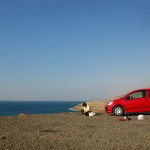
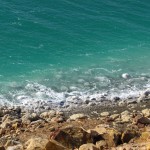

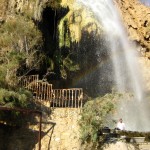
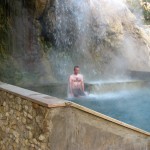


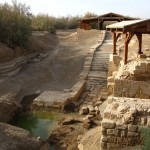
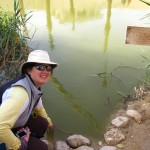
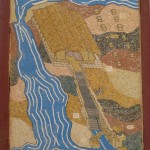


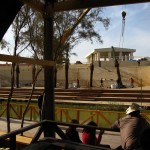

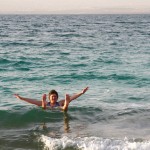
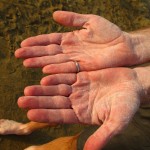
Interesting lots to see more than I would have thought